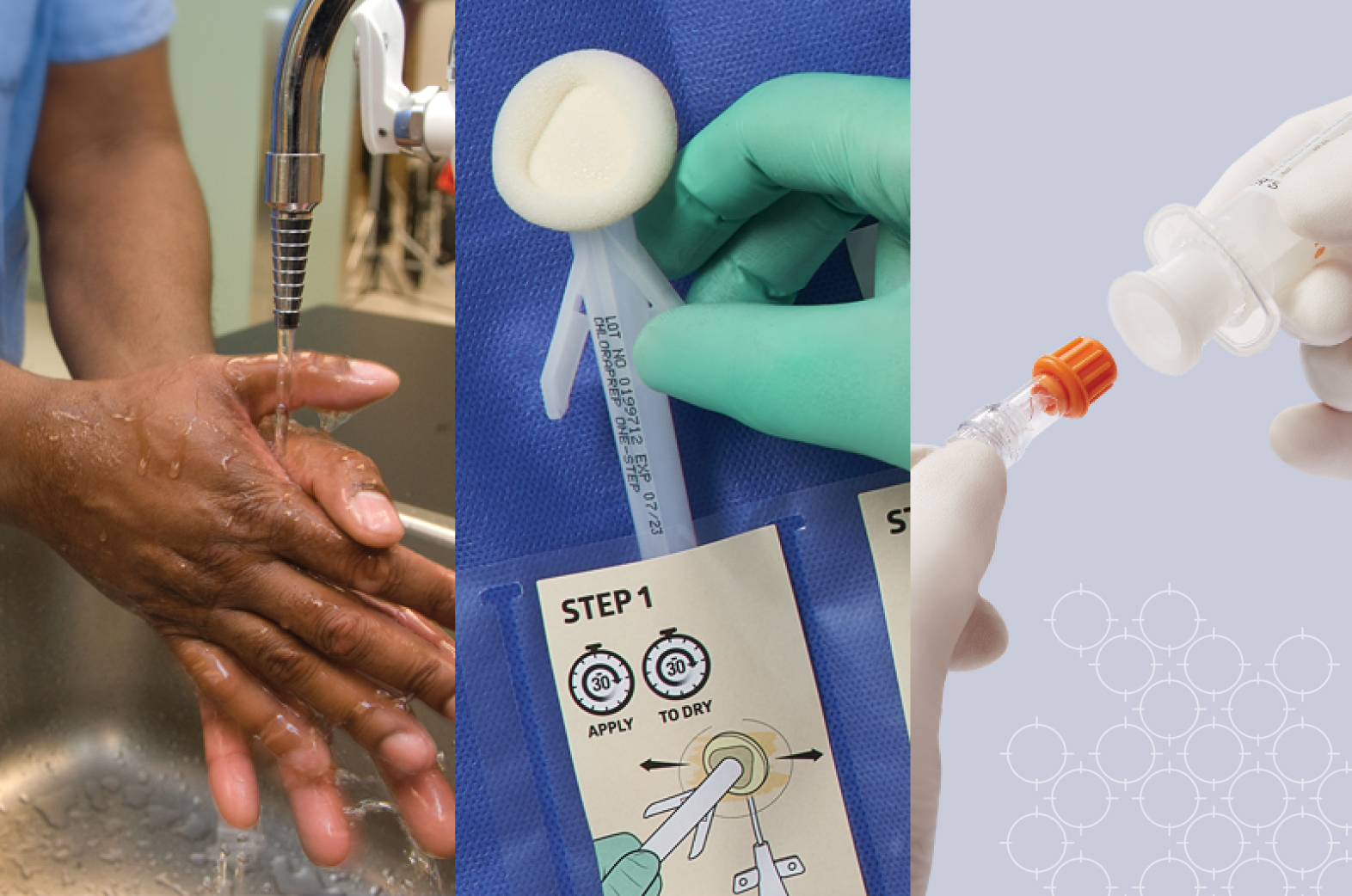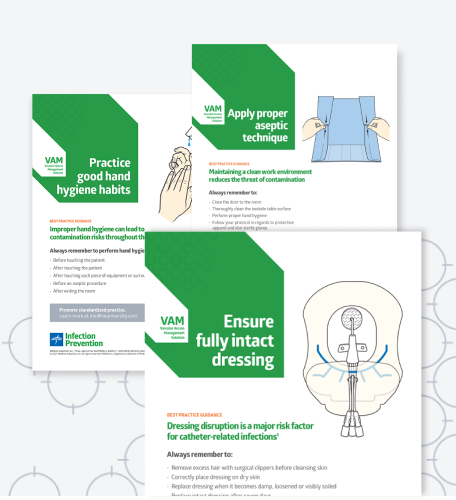Scrub the hub and more: How to promote consistent practice
3 tips for standardizing process, starting with central line insertion.

Every day, clinicians strive to standardize protocols that can help keep patients safe and prevent infection. But during a hectic shift, even practicing proper hand hygiene can be a challenge. For example, on a recent hospital visit to observe nurses changing central venous catheter dressings, Vincent Tessitore, Medline Clinical Resource Manager, Critical Care, was quick to lather up every time he entered and left a patient’s room. Two days and about 100 hand washings later, his dry, chapped hands were evidence of his good practice. But what was surprising, “I didn’t see other clinicians with the same problem,” Tessitore says.
Tessitore knows he probably caused the irritation by scrubbing too much. But as a Clinical Resource Manager, he wants to set a high bar for fellow clinicians. We have to “follow what we preach” to help reduce practice variation and lower the risk of infection, he explains.
Hand hygiene is key to reducing cross-contamination in a healthcare setting and one of several best practices that help prevent catheter-associated bloodstream infections (CABSIs). But busy shifts, multiple patients to manage and different levels of training can lead to inconsistent practice and an increased risk of infection. The result: more than 30,000 central line-associated bloodstream infections (CLABSIs) occur annually in intensive care units of acute care facilities.1
More than 30,000
CLABSIs occur annually in intensive care units of acute care facilities1
To help reduce care variation, it’s important to understand the daily challenges that can prevent clinicians from consistently following best practices. Use this guide to help identify and prevent three major lapses in practice, from line insertion to removal, that can lead to CABSIs.
1 | Lapses in hand hygiene compliance
Clinicians know the importance of washing hands before and after inserting, replacing, accessing, repairing or dressing a venous catheter.2 They also know to wash between patients, before donning or removing gloves, after using the bathroom and when there’s evidence of contamination.2 But the hectic demands of daily patient care can make it hard for them to keep hand washing top-of-mind. In fact, 44% of observed clinicians in 2019 did not perform hand hygiene during dressing changes.3 And, since germs spread by touch, inconsistent hand hygiene puts patients at risk of infection.
44%
of observed clinicians in 2019 did not perform hand hygiene during dressing changes3
So, what can you do to help your clinicians make hand hygiene second nature? Begin by creating and sharing educational materials like easy-to-read bulletin boards, posters or checklists. Another good approach is to designate nurse leaders in every unit to help encourage consistent practices. Support their efforts by making hand sanitizer available outside of patient rooms, by the bedside and in a personal carry bottle for clinicians to use. Insertion and maintenance bundles that include hand sanitizer can also help increase practice compliance. When clinicians consistently follow evidence-based practices like hand hygiene, up to 70% of central line-associated bloodstream infections (CLABSIs) may be prevented.4
70%
of CLABSIs may be prevented when clinicians consistently follow evidence-based practices like hand hygiene4
2 | Gaps in aseptic technique
Following consistent aseptic technique during insertion or maintenance involves multiple steps and products—setting up the sterile field, using the proper PPE, disinfecting the skin around the insertion site, and changing the dressing. The fact is, many of these steps aren’t followed consistently. For instance, 51% of recently observed nurses didn’t keep their dressing changes fully sterile.3
51%
of recently observed nurses didn’t keep their dressing changes fully sterile3
Insertion and maintenance kits help drive best practice compliance by providing and organizing all products clinicians need for a correct and safe procedure. Having a second person monitor insertion and maintenance procedures can also help clinicians identify gaps in aseptic technique.5
3 | Inconsistent scrubbing of the catheter hub
Another practice that’s often missed is scrubbing the catheter hub. Any time clinicians hook up a flush syringe, they need to scrub the hub with alcohol or chlorhexidine to prevent cross contamination.6,7 “Hub scrubbing with friction should happen for at least 15 seconds and needs to occur on the threads and the septum of the needleless connector,” Tessitore says. But this doesn’t happen every time. When it does, the intensity and time spent scrubbing can vary widely.
One way to help drive consistent practice is to standardize on a flush syringe with a disinfection cap integrated in the top of the plunger. It makes the process more convenient because “the cap is right there, so clincians don’t have to stop what they’re doing,” Tessitore explains.
There’s just one word of caution: When clinicians are working in busy shifts, a disinfection cap can make it tempting to skip scrubbing in between flushes. But having this extra convenience doesn’t eliminate the possibility of bacteria invading the catheter or its content any time the line is flushed.
“If I want to do what’s best for the patient, whether there was an alcohol cap on or not, I would scrub every time I hook the syringe. That’s my professional opinion,” Tessitore says.

Key takeaway
Your clinicians work hard to protect their patients. But every catheter insertion, line access and dressing change can lead to microbes invading the patient’s body. A comprehensive vascular access health program can help your clinicians avoid lapses in practice that can lead to CABSIs. It’s essential that the program includes guidance on key practices like hand hygiene and hub disinfection, relevant education and a system of products that drives compliance and supports prevention guidelines.
Looking for more ways to help your clinicians keep patients safe from CLABSIs?
Explore our BSI 2019 Discovery Assessment Findings.
Sign up for a BSI Discovery Assessment to identify gaps in care at your facility and receive a customized action plan to help improve infection rates.
Learn how to create a culture of prevention with our Vascular Access Management Solution.
Encourage staff to follow evidence-based practices for CABSI prevention. Read about human factors that can help reduce variation in care.
References:
1. Bloodstream Infection Event (Central Line-Associated Bloodstream Infection and Non-Central Line-Associated Bloodstream Infection). Center for Disease Control and Prevention website. Available at: https://www.cdc.gov/nhsn/pdfs/pscmanual/4psc_clabscurrent.pdf, Accessed March 4, 2021.
2. DeVries M. (2019) Insertion Related Infection Prevention with Vascular Access Devices. In: Moureau N. (eds) Vessel Health and Preservation: The Right Approach for Vascular Access. Springer, Cham. https://doi.org/10.1007/978-3-030-03149-7_10, Accessed February 12, 2021.
3. BSI 2019 Discovery Assessment Findings. Available at https://meddevod.wpdev.medline.com/media/catalog/Docs/MKT/WP/OTH-EBSI-Discovery-Assessment-Overview-11-20.pdf, Accessed on February 5, 2021.
4. Association for Professionals in Infection Control and Epidemiology. Guide to Preventing Central Line-Associated Bloodstream Infections. Washington, DC; APIC Implementation Guides, December 2015. Available at: http://apic.org/Professional-Practice/Implementation-guides/#implementaion-guide-7464, Accessed March 4, 2021.
5. Central Line Insertion Practices (CLIP) Adherence Monitoring. Center for Disease Control and Prevention website. Available at: https://www.cdc.gov/nhsn/pdfs/pscmanual/5psc_clipcurrent.pdf, Accessed March 4, 2021.
6. Moureau NL, Flynn J. Disinfection of Needleless Connector Hubs: Clinical Evidence Systematic Review. Nursing Research and Practice. 2015;2015:796762. Available at: https://www.hindawi.com/journals/nrp/2015/796762/, Accessed March 4, 2021.
7. Scrub the Hub! The Joint Commission website. Available at: https://www.jointcommission.org/-/media/tjc/documents/resources/health-services-research/clabsi-toolkit/clabsi_toolkit_tool_3-21_scrub_the_hubpdf.pdf?db=web&hash=79BF0D29BD4AAF13DEC3C3DE5AB90494, Accessed March 4, 2021.

